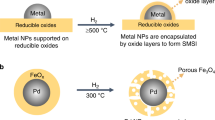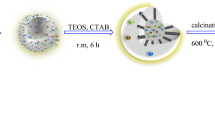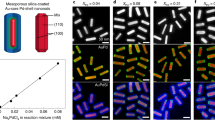Abstract
Single-atom catalysts often exhibit unexpected catalytic activity for many important chemical and biological reactions with respect to their bulk counterparts, and have been recognized as potential substitutes for natural enzymes. Here we report a biomimetic composite, yolk–shell Pd1@Fe1, that features two compatible single-atom systems with atomically dispersed Fe1 sites in a N-doped carbon shell and Pd1 sites in a yolk derived from a metal–organic framework. Directly utilizing the O2 and H2 sources generated on-site from the electrocatalytic overall water splitting, the as-synthesized yolk–shell Pd1@Fe1 could simultaneously catalyse nitroaromatic hydrogenation and alkene epoxidation reactions and lead to a cascade synthesis of amino alcohols. Our findings provide a versatile strategy to integrate different single metal sites within one system to allow the continuous and easy synthesis of complex compounds for various challenging reactions.

This is a preview of subscription content, access via your institution
Access options
Access Nature and 54 other Nature Portfolio journals
Get Nature+, our best-value online-access subscription
$29.99 / 30 days
cancel any time
Subscribe to this journal
Receive 12 digital issues and online access to articles
$119.00 per year
only $9.92 per issue
Buy this article
- Purchase on Springer Link
- Instant access to full article PDF
Prices may be subject to local taxes which are calculated during checkout





Similar content being viewed by others
Data availability
The data that support the findings of this study are available from the corresponding author upon reasonable request. Source data are provided with this paper.
References
Lubitz, W., Ogata, H., Rudiger, O. & Reijerse, E. Hydrogenases. Chem. Rev. 114, 4081–4148 (2014).
Schwizer, F. et al. Artificial metalloenzymes: reaction scope and optimization strategies. Chem. Rev. 118, 142–231 (2018).
Wodrich, M. D. & Hu, X. Natural inspirations for metal–ligand cooperative catalysis. Nat. Rev. Chem. 2, 0099 (2017).
Suryanto, B. H. R. et al. Challenges and prospects in the catalysis of electroreduction of nitrogen to ammonia. Nat. Catal. 2, 290–296 (2019).
Barber, J. Photosynthetic energy conversion: natural and artificial. Chem. Soc. Rev. 38, 185–196 (2009).
Kumaravel, V. et al. Photoelectrochemical conversion of carbon dioxide (CO2) into fuels and value-added products. ACS Energy Lett. 5, 486–519 (2020).
Pan, H.-J. et al. A catalytically active [Mn]-hydrogenase incorporating a non-native metal cofactor. Nat. Chem. 11, 669–675 (2019).
Bhagidamodaran, A. et al. Why copper is preferred over iron for oxygen activation and reduction in haem–copper oxidases. Nat. Chem. 9, 257–263 (2017).
Huang, L. et al. Single-atom nanozymes. Sci. Adv. 5, eaav5490 (2019).
Yang, X. F. et al. Single-atom catalysts: a new frontier in heterogeneous catalysis. Acc. Chem. Res. 46, 1740–1748 (2013).
Jones, J. et al. Thermally stable single-atom platinum-on-ceria catalysts via atom trapping. Science 353, 150–154 (2016).
Chen, Y. et al. Single-atom catalysts: synthetic strategies and electrochemical applications. Joule 2, 1242–1264 (2018).
Liu, J. Catalysis by supported single metal atoms. ACS Catal. 7, 34–59 (2017).
Liu, P. et al. Photochemical route for synthesizing atomically dispersed palladium catalysts. Science 352, 797–800 (2016).
Wang, L. et al. Atomic-level insights in optimizing reaction paths for hydroformylation reaction over Rh/CoO single-atom catalyst. Nat. Commun. 7, 14036 (2016).
Zitolo, A. et al. Identification of catalytic sites in cobalt–nitrogen–carbon materials for the oxygen reduction reaction. Nat. Commun. 8, 957 (2017).
Kunwar, D. et al. Stabilizing high metal loadings of thermally stable platinum single atoms on an industrial catalyst support. ACS Catal. 9, 3978–3990 (2019).
Cavka, J. H. et al. A new zirconium inorganic building brick forming metal organic frameworks with exceptional stability. J. Am. Chem. Soc. 130, 13850–13851 (2008).
Zhao, Y. et al. Two-step carbothermal welding to access atomically dispersed Pd1 on three-dimensional zirconia nanonet for direct indole synthesis. J. Am. Chem. Soc. 141, 10590–10594 (2019).
Wong, A. et al. Synthesis of ultrasmall, homogeneously alloyed, bimetallic nanoparticles on silica supports. Science 358, 1427–1430 (2017).
Wu, H. et al. Highly doped and exposed Cu(i)–N active sites within graphene towards efficient oxygen reduction for zinc–air batteries. Energy Environ. Sci. 9, 3736–3745 (2016).
Gao, G., Jiao, Y., Waclawik, E. R. & Du, A. Single atom (Pd/Pt) supported on graphitic carbon nitride as an efficient photocatalyst for visible-light reduction of carbon dioxide. J. Am. Chem. Soc. 138, 6292–6297 (2016).
Liu, W. et al. Single-site active cobalt-based photocatalyst with a long carrier lifetime for spontaneous overall water splitting. Angew. Chem. Int. Ed. 56, 9312–9317 (2017).
Wei, S. et al. Direct observation of noble metal nanoparticles transforming to thermally stable single atoms. Nat. Nanotechnol. 13, 856–861 (2018).
Liu, W. et al. Single-atom dispersed Co–N–C catalyst: structure identification and performance for hydrogenative coupling of nitroarenes. Chem. Sci. 7, 5758–5764 (2016).
Qiao, B. et al. Single-atom catalysis of CO oxidation using Pt1/FeOx. Nat. Chem. 3, 634–641 (2011).
Fei, H. et al. General synthesis and definitive structural identification of MN4C4 single-atom catalysts with tunable electrocatalytic activities. Nat. Catal. 1, 63–72 (2018).
Suenaga, K. et al. Radially modulated nitrogen distribution in CNx canotubular structures prepared by CVD using Ni phthalocyanine. Chem. Phys. Lett. 316, 365–372 (2000).
Li, Z. et al. Iridium single-atom catalyst on nitrogen-doped carbon for formic acid oxidation synthesized using a general host−guest strategy. Nat. Chem. 12, 764–772 (2020).
Gu, J. et al. Atomically dispersed Fe3+ sites catalyze efficient CO2 electroreduction to CO. Science 364, 1091–1094 (2019).
Zhang, Z. et al. The simplest construction of single-site catalysts by the synergism of micropore trapping and nitrogen anchoring. Nat. Commun. 10, 1657 (2019).
Wang, X. et al. Uncoordinated amine groups of metal–organic frameworks to anchor single Ru sites as chemoselective catalysts toward the hydrogenation of quinoline. J. Am. Chem. Soc. 139, 9419–9422 (2017).
Wang, J. et al. Design of N-coordinated dual-metal sites: a stable and active Pt-free catalyst for acidic oxygen reduction reaction. J. Am. Chem. Soc. 139, 17281–17284 (2017).
Lin, L. et al. Low-temperature hydrogen production from water and methanol using Pt/α-MoC catalysts. Nature 544, 80–83 (2017).
Corma, A. et al. Exceptional oxidation activity with size-controlled supported gold clusters of low atomicity. Nat. Chem. 5, 775–781 (2013).
Yao, Y. et al. High temperature shockwave stabilized single atoms. Nat. Nanotechnol. 14, 851–445 857 (2019).
Chen, Z. et al. A heterogeneous single-atom palladium catalyst surpassing homogeneous systems for Suzuki coupling. Nat. Nanotechnol. 13, 702–707 (2018).
Zhang, L. et al. Graphene defects trap atomic Ni species for hydrogen and oxygen evolution reactions. Chem 4, 285–297 (2018).
Zhang, Z. et al. Thermally stable single atom Pt/m-Al2O3 for selective hydrogenation and CO oxidation. Nat. Commun. 8, 16100 (2017).
Genovese, C. et al. Operando spectroscopy study of the carbon dioxide electro-reduction by iron species on nitrogen-doped carbon. Nat. Commun. 9, 935 (2018).
Sabater, S. et al. Catalyst enhancement and recyclability by immobilization of metal complexes onto graphene surface by noncovalent interactions. ACS Catal. 4, 2038–2047 (2014).
Feng, X. et al. Engineering a highly defective stable UiO-66 with tunable Lewis–Brønsted acidity: the role of the hemilabile linker. J. Am. Chem. Soc. 142, 3174–3183 (2020).
Acknowledgements
This work was supported by the National Key R&D Program of China 2017YFA (0208300 and 0700104), the National Natural Science Foundation of China (21522107, 21671180, 21521091, U1463202 and 21873050). We thank the photoemission endstations BL1W1B at the Beijing Synchrotron Radiation Facility (BSRF), BL14W1 at the Shanghai Synchrotron Radiation Facility (SSRF) and BL10B and BL11U in the National Synchrotron Radiation Laboratory (NSRL) for help in the characterizations.
Author information
Authors and Affiliations
Contributions
Y.W. developed the idea and designed experiments. Y.Z. and H.Z. conceived and performed most of the experiments. Y.Q., C.X., Z.X., Q.Z., F.Z., X.M., W.W., M.C., Y.X., X. Lin, H.W. and W.H. participated in some of the experimental work. X.Z. and Y. Li performed the theoretical calculations. L.G., J.L. and Y. Lin performed the aberration-corrected STEM characterizations. X. Liu, W.C., Z.J., L.Z., T.Y., J.D. and S.W. carried out the XFAS characterizations. All the authors discussed the results and commented on the manuscript.
Corresponding authors
Ethics declarations
Competing interests
The authors declare no competing interests.
Additional information
Peer review information Nature Catalysis thanks the anonymous reviewers for their contribution to the peer review of this work.
Publisher’s note Springer Nature remains neutral with regard to jurisdictional claims in published maps and institutional affiliations.
Supplementary information
Supplementary Information
Supplementary Figs. 1–43, notes and Tables 1–4.
Source data
Source Data Fig. 1
XRD data for Fig. 2a.
Source Data Fig. 2
57Fe Mössbauer spectra of yolk–shell Pd1@Fe1.
Source Data Fig. 3
EXAFS of single-atom Pd1 sites and Fe1 sites.
Source Data Fig. 4
FT-EXAFS spectra for Fig.2d.
Source Data Fig. 5
The Bader charge of Fe1-CxN4–x (0 ≤ x ≤ 4) and Pd1-CyN4–y (0 ≤ y ≤ 4) structures.
Rights and permissions
About this article
Cite this article
Zhao, Y., Zhou, H., Zhu, X. et al. Simultaneous oxidative and reductive reactions in one system by atomic design. Nat Catal 4, 134–143 (2021). https://doi.org/10.1038/s41929-020-00563-0
Received:
Accepted:
Published:
Issue Date:
DOI: https://doi.org/10.1038/s41929-020-00563-0
This article is cited by
-
D-band center coordination modulated enzyme-like activity in Fe-Cu dual-metal single-atom nanozymes
Nano Research (2024)
-
Advances in bio-inspired electrocatalysts for clean energy future
Nano Research (2024)
-
Cell-inspired design of cascade catalysis system by 3D spatially separated active sites
Nature Communications (2023)
-
Catalytic ozonation mechanism over M1-N3C1 active sites
Nature Communications (2023)
-
Construction of highly dispersed Pt single sites and high-efficiency-heterocatalysis silylation of alcohols with silanes
Nano Research (2023)



